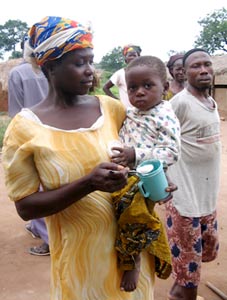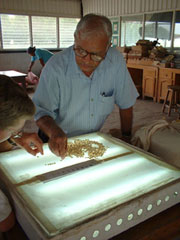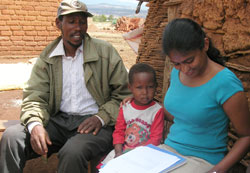
It looks and tastes like any other maize, but hidden inside each bite of quality protein maize (QPM) are specialized natural molecules waiting to give the diner an extra boost. A new study evaluates the nutritional impact of QPM on target populations.
Eating quality protein maize (QPM) increases the growth rate of moderately malnourished children who survive on a maize-dominated diet, according to a new study co-authored by five scientists, including two CIMMYT maize experts.
QPM grain is a biofortified, non-transgenic food that provides improved protein quality to consumers. It looks and tastes like normal maize, but QPM contains a naturally-occurring mutant maize gene that increases the amount of two amino acids—lysine and tryptophan—necessary for protein synthesis in humans. The total amount of protein in QPM is not actually increased, but rather the protein is enhanced so that it delivers a higher benefit when consumed by monogastric beings, like humans and pigs. Drawing on three decades of previous studies on QPM and using sophisticated statistical analysis, the paper “A meta-analysis of community-based studies on quality protein maize,” published in Food Policy, shows that when children suffering from malnutrition in maize-dependent areas consume QPM instead of conventional maize, they benefit from a 12% increased growth rate for weight and a 9% increased growth rate for height.
“We tried to bring together all the relevant work we could find on QPM and analyze and discuss it as transparently as possible,” said Nilupa Gunaratna, statistician at the International Nutrition Foundation and the paper’s lead author. “We discussed all the strengths and weaknesses of past studies, and took these into account in our evaluation. We also proceeded very conservatively, trying different methods, studying the effects of individual studies and outliers. In every approach, we came to the same conclusion: QPM has a positive effect on the growth of undernourished infants and young children for whom maize is a staple food.”

Give the people what they eat
Maize is the third-most important cereal crop for direct consumption (after rice and wheat), and is particularly significant in developing areas, such as Africa, where it is the main food source for more than 300 million people. In 12 developing countries, it accounts for more than 30% of total dietary protein. And though maize alone cannot provide all the nutrients needed for a healthy diet, maize with extra essential nutrients can go a long way toward helping the nearly 200 million children in poor nations who suffer stunted growth from malnutrition and for whom a diversified diet is currently unattainable.
“Staple foods are the cheapest foods, and the poorer you are, the more you depend on them, which often does not provide a balanced diet,” said co-author Kevin Pixley, who divides his time between CIMMYT and HarvestPlus. “We would all prefer to see each and every person eating a healthy and balanced diet, but that isn’t always possible. Biofortification is one part of the strategy to help combat malnutrition.”
QPM complexities
Though QPM is more nutritious than conventional maize and many of its varieties yield as well as or better than popular conventional maize varieties, widespread acceptance of QPM remains elusive. Of the 90 million hectares of maize grown in Mexico, Central America, sub-Saharan Africa, and Asia, only an estimated 1% or less is QPM.
Many seed companies lack interest in QPM because of the research costs and challenges of assuring its superior nutritional quality. If QPM is grown next to fields of conventional maize, cross-pollination will dilute the QPM trait, and QPM also requires separate storage and quality testing/monitoring. This and the fact that the enhanced maize brings no market premium—largely because its quality trait is not visibly distinguishable—have often deterred seed companies from marketing QPM altogether.
Yet in areas where there has been a substantial effort to promote it and make quality seed available, QPM has gained ground. For example, in 1992 Ghana released its first QPM variety, Obatanpa. Obatanpa is an open-pollinated variety, meaning its grain can be saved by farmers and re-sown as seed without any major decline in yield. In 2005, it was calculated that Obatanpa accounted for over 90% of improved seed sales in Ghana. In 2008, Wayne Haag of the Sasakawa Africa Association estimated that 350,000 hectares of QPM were grown in Ghana, making it the world’s largest QPM grower. Strong support and effort by multidisciplinary institutions, including the Ghanaian government, made this possible. Four of the QPM studies used in the meta-analysis were based in Ghana. Obatanpa’s high and stable yields and end-use quality have made it popular not only in Ghana but in several other sub-Saharan African countries, where it has been released under other names.

Fortifying future research
The authors of the QPM meta-analysis—two statisticians, an economist, a nutritionist, and a plant breeder—hope its clear results will finally dissuade QPM critics, many of whom have questioned whether QPM offers nutritional benefits for humans, and that the paper will lead to renewed efforts to explore improved nutrition through biofortified crops. “While there is still interesting and important nutritional research to be done on QPM, I hope the focus will start to shift from whether QPM has a benefit to how QPM can be promoted, disseminated, and used by farmers and consumers to have the most impact,” said Gunaratna. CIMMYT is currently involved in several QPM projects, including the QPM Development (QPMD) project in Africa, which is funded by the Canadian International Development Agency (CIDA). Launched in 2003, the project uses QPM as a key tool for improving food security, nutrition, and the incomes of resource-poor farming families in four countries (Ethiopia, Kenya, Tanzania, and Uganda). In the project’s first five years, seven new QPM varieties were released (bringing the total in the region to 12) and education efforts resulted in 270 field days attended by over 37,000 farmers, roughly 40% of whom were women. CIDA also funds AgroSalud, a five-year project that started in 2005 to extend the benefits of nutritionally improved staple crops to Latin America and the Caribbean. In 2002, two CIMMYT scientists received the World Food Prize for their work to develop QPM.